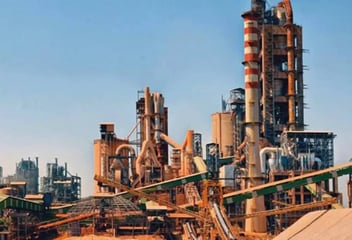The Cement Manufacturing Process - Environmental and Social Impact
The cement industry is among India’s most polluting industries. Image courtesy: businesstoday.in
The Indian cement industry is the second-largest producer of cement globally. In the financial year 2020, the Indian cement industry had a turnover of Rs 64,000 crore. Dominated by around 30 prominent players, the Indian cement industry comprises around 210 large cement producing plants and 365 small ones. The industry continues to enjoy robust market demand through the pandemic situation, as India continues to be the second-largest global consumer of cement.
On the other hand, the cement industry is one of the most significant contributors to air pollution1. The cement industry contributes to around 7% of global carbon emissions. Particulate matter (PM) emissions from cement plants are very high, and cement is understood to be the most polluting industry in the world.
What are Fugitive Emissions?
Fugitive emissions refer to pollutants that are ‘fugitive’ or escape from a source without being accounted for. Regular emissions from known sources are accounted for and hence easier to track and control. Fugitive emissions, on the other hand, are difficult to track since their source is unknown. Hence, they contribute to ambient air pollution in an untraceable way. The problem of fugitive emissions occurs during every stage of the cement manufacturing process and poses a huge challenge.
How is cement made? Steps Involved in Manufacturing Cement
Manufacturing of cement is a detailed process, involving several steps. Fugitive emissions are released in each of these processes, as detailed in the info graphic below.
- Mining - The first step in cement manufacturing is mining. So, what is cement made of? Technically, the raw material for cement composition is mined from limestone quarries, a variety of processes such as drilling, blasting, crushing, transporting, and stockpiling are involved, which result in the emissions of particulate matter and carbon dioxide
- Raw Material Preparing - The raw material or cement ingredients are mixed and ground to consistency in processes that are either dry, wet, or semi-dry. In the processes of both grinding and further transporting to the kilns, fugitive emissions of particulate matter happen.
- Kiln Processing -This process involves combusting in the kiln. The raw cement ingredients are heated and clinkers or hard, spherical nodules are produced as a result. Cement Kiln processing involves the following stages: drying or preheating, calcining, and clinker cooling. Calcination is the process of burning the raw mix at a high temperature so that clinkers are formed. These clinkers are later cooled by air blowers before being transported to the cement mill. Emissions at this stage are mainly in the form of gases such as carbon dioxide, SOx, NOx, carbon monoxide, and hydrocarbons. These are released both from the mixture that is being burned and treated, and the fuel used for burning.
- Cement Milling -This is the final stage in cement manufacturing, where the clinkers are ground into a fine powder cement. Certain chemicals are added in order to set the cement. This stage is also called finish milling. The emissions released during this stage include particulate matter, SOx, and NOx.
- Cement Packaging - This involves the dispatch and conveyance of cement. Particulate matter emissions happen significantly in this stage, during the loading, transport, unloading, and storage of cement from the warehouse to construction sites.
Evidently, the predominant fugitive emission in the cement industry is that of particulate matter. In addition to the above-mentioned emissions, VOCs are released during other industrial processes associated with these stages.
Wondering how to tackle fugitive emissions at your cement manufacturing plant?
Book a free consultation with our Air Quality Experts Today!
(This article is conceptualized and co-written by Shashank Aggarwal & Vidhya Srinivasan)
Citations
- https://economictimes.indiatimes.com/news/international/world-news/cement-produces-more-pollution-than-all-the-trucks-in-the-world/articleshow/69919005.cms?from=mdr
- https://indianexpress.com/article/india/india-others/death-by-breath-why-building-dust-is-lethal-mix/
- https://www.witpress.com/elibrary/wit-transactions-on-ecology-and-the-environment/42/3892
- https://business.mapsofindia.com/cement/cement-industry-jobs.html
- https://link.springer.com/chapter/10.1007/978-3-030-44248-4_18
- https://www.thehindu.com/news/cities/Delhi/cpwd-fined-5-lakh-for-flouting-pollution-control-norms/article32704680.ece
- https://link.springer.com/article/10.1007/s10098-020-01998-6
- https://www.downtoearth.org.in/news/environment/cement-industry-misses-deadline-for-new-pollution-norms-57548

.svg)
.webp?width=1080&height=1080&name=Free%20Case%20Study%20Steel%20Plant%20(1).webp)






Post Comments